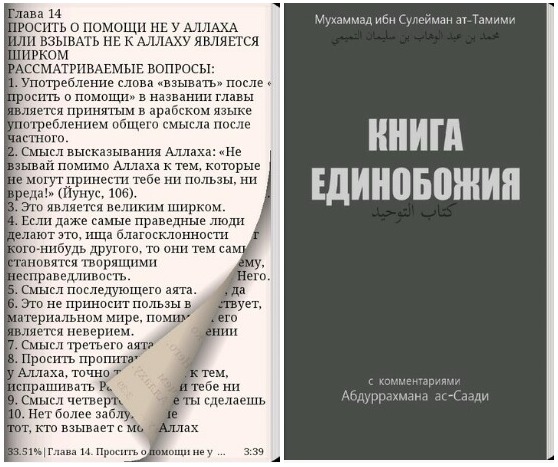Kniga Edinobozhiya Muhammad Ibn Sulejman At Tamimi

Influenced •,,,, [ ],, Muhammad ibn `Abd al-Wahhab ibn Sulayman ibn Ali ibn Muhammad ibn Ahmad ibn Rashid Abu Abdullah al- Tamimi Muhammad ibn Abd al-Wahhab (;: محمد بن عبد الوهاب; 1703 – 22 June 1792) was a religious leader and from in central who founded the movement now called. Born to a family of, Ibn 'Abd al-Wahhab's early education consisted of learning a fairly standard curriculum of according to the, which was the school of law most prevalent in his area of birth.
This is a useful handbook for every Muslim who wishes to please Allah and to avoid His wrath by learning what Allah has proscribed for him or her and making.

Despite his initial rudimentary training in classical Sunni Muslim tradition, Ibn 'Abd al-Wahhab gradually became opposed to many of the most popular Sunni practices such as the, which he felt amounted to or even. Despite his teachings being rejected and opposed by many of the most notable Sunni Muslim scholars of the period, including his own father and brother, Ibn 'Abd al-Wahhab charted a religio-political pact with to help him to establish the, the first Saudi state, and began a dynastic alliance and power-sharing arrangement between their families which continues to the present day in the Kingdom of. The, Saudi Arabia's leading religious family, are the descendants of Ibn ʿAbd al-Wahhab, and have historically led the in the Saudi state, dominating the state's clerical institutions. Contents • • • • • • • • • • • • • • • • • • • Early years [ ] Ibn 'Abd al-Wahhab is generally acknowledged to have been born in 1703 into the sedentary and impoverished Arab clan of in, a village in the region of central Arabia. Before the emergence of Wahhabism there was a very limited history of Islamic education in the area.
For this reason, Ibn 'Abd al-Wahhab had modest access to Islamic education during his youth. Despite this, the area had nevertheless produced several notable of the, which was the school of law most prominently practiced in the area. In fact, Ibn 'Abd-al-Wahhab's own family 'had produced several doctors of the school,' with his father, Sulaymān b. Muḥammad, having been the Hanbali of the Najd and his grandfather, ʿAbd al-Wahhāb, having been a of Hanbali law. Ibn 'Abd-al-Wahhab's early education consisted of learning the by heart and studying a rudimentary level of and as outlined in the works of (d. 1223), one of the most influential medieval representatives of the Hanbali school whose works were regarded 'as having great authority' in the Najd. As the and the belief in their had become one of the most omnipresent and established aspects of Sunni Muslim practice throughout the Islamic world, being an agreed upon tenet of the faith by, it was not long before Ibn 'Abd-al-Wahhab began to encounter the omnipresence of saint-veneration in his area as well; and it is probable that he chose to leave Najd and look elsewhere for studies in order to see if the honoring of saints was as popular in the neighboring places of the Muslim world.
After leaving 'Uyayna, Ibn 'Abd al-Wahhab performed the in, where the scholars appear to have held opinions and espoused teachings that were unpalatable to him. After this, he went to, the stay at which seems to have been 'decisive in shaping the later direction of his thought.' In Medina, he met a Hanbali theologian from Najd named ʿAbd Allāh b. Ibrāhīm al-Najdī, who had been a supporter of the neo-Hanbali works of (d. 1328), the controversial medieval scholar whose teachings had been considered heterodox and misguided on a number of important points by the vast majority of Sunni Muslim scholars up to that point in history. Ibn 'Abd al-Wahhab's teacher Abdallah ibn Ibrahim ibn Sayf introduced the relatively young man to in who belonged to the order () of and recommended him as a student. Mohammad Ibn Abd-al-Wahhab and al-Sindhi became very close and Mohammad Ibn Abd-al-Wahhab stayed with him for some time.
Download the kooks inside in inside out rar zip free. ZIP Download Inside In/Inside Out The Kooks album on Freeallmusic. Download Full album with single direct link & extract.zip file after free download (No Password Required).
Muhammad Hayya also taught Mohammad Ibn ʿAbd-al-Wahhab to reject popular religious practices associated with and their tombs that resembles later Wahhabi teachings. Following his early education in, Ibn Abdul Wahhab traveled outside of the peninsula, venturing first to. [ ] Early preaching [ ] After his return home, Ibn ʿAbd al-Wahhab began to attract followers, including the ruler of 'Uyayna, Uthman ibn Mu'ammar. With Ibn Mu'ammar, Ibn ʿAbd al-Wahhab came to an agreement to support Ibn Mu'ammar's political ambitions to expand his rule 'over Najd and possibly beyond', in exchange for the ruler's support for Ibn ʿAbd al-Wahhab's religious teachings. Ibn ʿAbd al-Wahhab began to implement some of his ideas for reform. First, he persuaded Ibn Mu'ammar to help him level the grave of, a, whose grave was revered by locals.
Secondly, he ordered the cutting down of trees considered sacred by locals, cutting down 'the most glorified of all of the trees' himself. Third, he organised the stoning of a woman who confessed to having committed adultery. These actions gained the attention of Sulaiman ibn Muhammad ibn Ghurayr of the tribe of, the chief of and, who held substantial influence in. Ibn Ghurayr threatened Ibn Mu'ammar with denying him the ability to collect a land tax for some properties that Ibn Mu'ammar owned in if he did not kill or drive away Ibn ʿAbd al-Wahhab. Consequently, Ibn Mu'ammar forced Ibn ʿAbd al-Wahhab to leave.